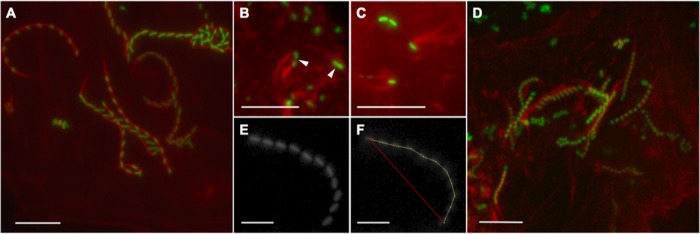FIG 2.

R. bellii transformants undergoing actin-based motility. Time-lapse micrographs in panels A and D to F were compiled as t-projections. (A) R. belliiMCS at 34°C. (B) Dividing rickettsiae may present actin tails on both joined bacteria, resulting in spinning. Measurements from dividing bacteria were not included in mean values of velocity or path curvature. Dividing rickettsiae are indicated by white arrowheads. (C) Twinned tails on single bacteria were occasionally visible, in this case on R. belliiMCS at 34°C. The red channel gamma value of this image was adjusted to accentuate the brightness of the actin tails against the background. (D) The R. belliiRmRickA mean velocity at 23°C is just over half that of the rickettsiae pictured in panel A. (E) Green channel fluorescent 10-movement t-stack of an R. belliiMCS variant at 34°C. (F) The t-stack pictured in panel E was measured to determine the velocity and path curvature. The path length (yellow line) was 43.7 μm and the elapsed time of the 10-movement stack was 118.25 s, yielding a velocity of 0.37 μm/s. The absolute distance traveled over the course of the t-stack was 37.2 μm, as indicated by the red line. Division of the absolute distance traveled (37.2 μm) by the path length (43.7 μm) yielded a path curvature value of 0.8513, which is very close to the mean value for R. belliiMCS at 34°C. Bars, 10 μm.
